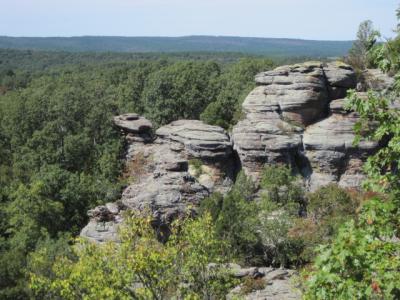Report describes Central Hardwoods forest vulnerabilities, climate change impacts

A new report from the US Forest Service, the Northern Institute of Applied Climate Science, and partners describes possible climate change effects in southern Illinois, southern Indiana and the Missouri Ozarks and assesses forests' vulnerability to changes. Credit: U.S. Forest Service
More than 30 scientists and forest managers contributed to the report, which is part of the Central Hardwoods Climate Change Response Framework, a collaboration of federal, state, academic and private partners led by the Forest Service's Northern Institute of Applied Climate Science (NIACS). “Central Hardwoods Ecosystem Vulnerability Assessment and Synthesis: A Report from the Central Hardwoods Climate Change Response Framework Project,” was published by the U.S. Forest Service's Northern Research Station and is available online at: http://www.nrs.fs.fed.us/pubs/45430
“People often think of climate change as being distant, either geographically or temporally,” said Leslie Brandt, the report's lead author and a climate change specialist with NIACS. “Our intent was to create a climate change resource that will be relevant to people who work, study, recreate, manage and care about the ecosystems in the Central Hardwoods Region.”
In the Central Hardwoods, the effects of a changing climate are expected to include rising temperatures due to a rise in greenhouse gas concentrations, leading to longer growing seasons. Winter temperatures are also expected to increase in the area, leading to changes in snow cover and soil frost. The nature and timing of precipitation will change, research suggests, with some studies showing that climate change will decrease soil moisture later in the growing season.
Other findings of the vulnerability assessment include:
- Conditions are expected to be less favorable for northern species such as sugar maple, American beech and white ash and become more suitable for southern species such as shortleaf pine.
- Forest fragmentation, an existing stressor for the region's forests, may reduce the ability of species that are adapted to future climate conditions to expand into new areas.
- Ecosystems that are adapted to frequent fire, such as open woodlands and savannas, may be more resilient to climate change because warmer temperatures are projected to increase the risk of wildfire.
“Plants, animals, and people all depend on forests and may all face additional challenges as temperatures increase and precipitation patterns shift,” said John Shuey, a co-author of the study and Director of Conservation Science for the Indiana Chapter of The Nature Conservancy. “But we don't have to wait until these changes wreak havoc on our forest habitats. We can start managing for the future today by nudging our forests towards species adapted to withstand future climates.”
More than a century of weather records demonstrate a changing climate for the Central Hardwoods, a region that is 40 percent forested, with about 80 percent of forested land privately owned. Since 1900, minimum temperatures in the Central Hardwood Region have increased by 1 to 2 degrees Fahrenheit and maximum temperatures have decreased by a similar amount. The region is receiving 12 to 17 percent more precipitation, particularly in the spring and fall since the turn of the last century. Over the past 30 years, more rain has been falling as heavy precipitation events of 3 inches or greater. Since the 1970s, a decrease in snow cover has led to an increase in soil frost.
“Confronting the challenge of climate change presents opportunities for managers and other decision-makers to plan ahead, foster resilient landscapes, and ensure that the benefits that forests provide are sustained into the future,” said Michael T. Rains, Director of the Northern Research Station and the Forest Products Laboratory. “Forest Service science is delivering tools and data that will help managers in the Central Hardwoods and throughout the nation meet this challenge.”
The Northern Institute of Applied Climate Science (NIACS) is a collaborative effort among the Forest Service, universities, and forest industry to provide information on managing forests for climate change adaptation, enhanced carbon sequestration, and sustainable production of bioenergy and materials. As a regional, multi-institutional entity, NIACS builds partnerships, facilitates research, and synthesizes information to bridge the gap between carbon and climate science research and the information and management needs of land owners and managers, policymakers, and members of the public.
The mission of the U.S. Forest Service is to sustain the health, diversity, and productivity of the nation's forests and grasslands to meet the needs of present and future generations. The agency has either a direct or indirect role in stewardship of about 80 percent of our nation's forests, amounting to 850 million acres including 100 million acres of urban forests gracing the nation's cities, where 80 percent of Americans live. The mission of the Forest Service's Northern Research Station is to improve people's lives and help sustain the natural resources in the Northeast and Midwest through leading-edge science and effective information delivery.
Media Contact
More Information:
http://www.fs.fed.usAll latest news from the category: Agricultural and Forestry Science
Newest articles

New model of neuronal circuit provides insight on eye movement
Working with week-old zebrafish larva, researchers at Weill Cornell Medicine and colleagues decoded how the connections formed by a network of neurons in the brainstem guide the fishes’ gaze. The…

Innovative protocol maps NMDA receptors in Alzheimer’s-Affected brains
Researchers from the Institute for Neurosciences (IN), a joint center of the Miguel Hernández University of Elche (UMH) and the Spanish National Research Council (CSIC), who are also part of…

New insights into sleep
…uncover key mechanisms related to cognitive function. Discovery suggests broad implications for giving brain a boost. While it’s well known that sleep enhances cognitive performance, the underlying neural mechanisms, particularly…



